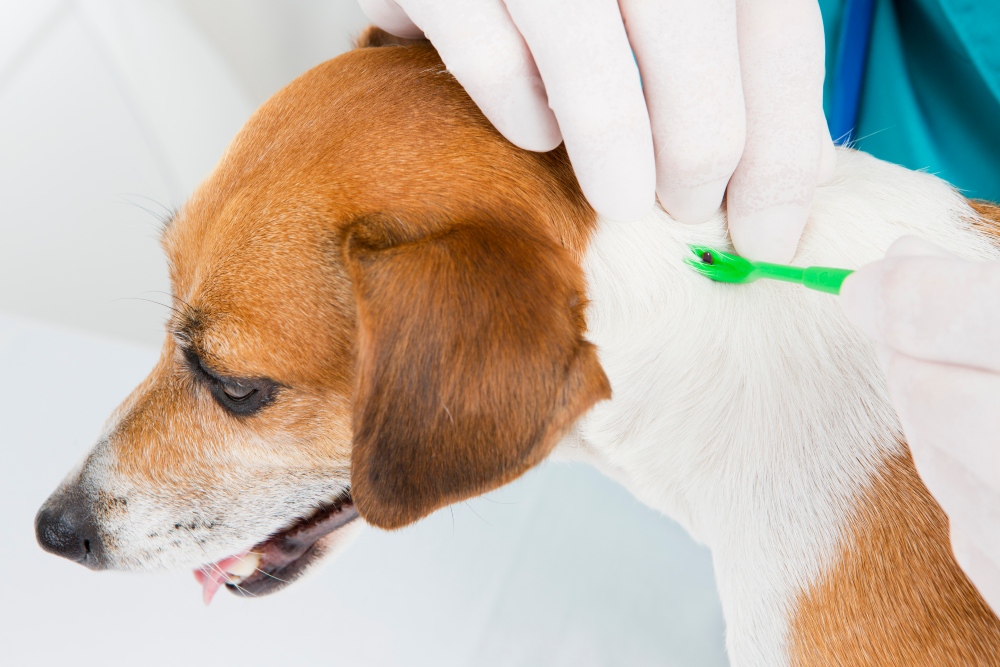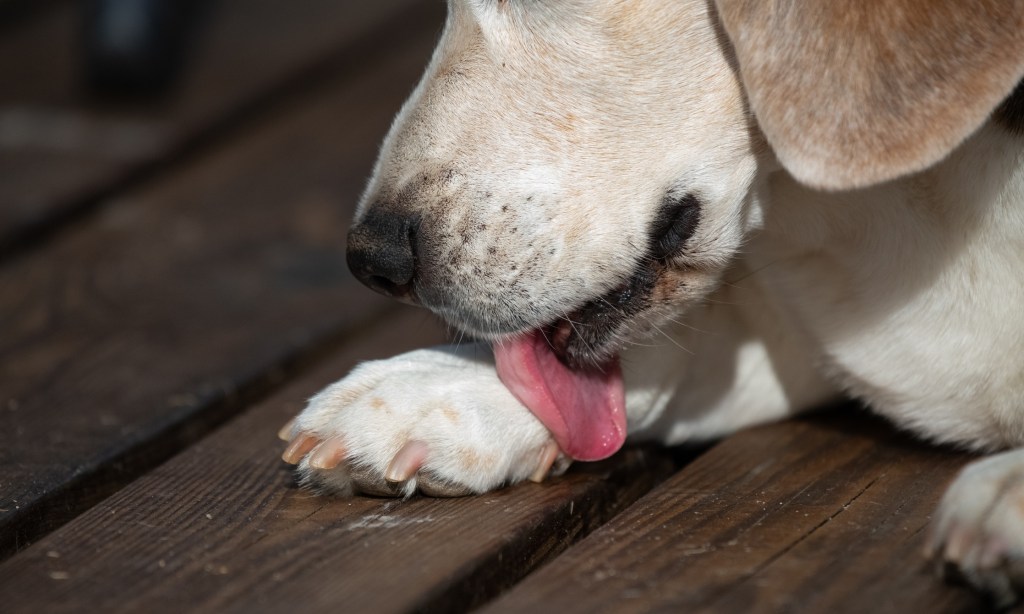Table of Contents
Ticks are disease-carrying parasites that are the bane of existence for many dogs and dog owners. During feeding sessions that can last for days, ticks transmit microorganisms responsible for illnesses, such as Lyme Disease and Rocky Mountain Spotted Fever, that can make dogs very sick.
Ticks love to hitch rides on unsuspecting dogs and start feeding. Disease transmission can occur within as little as 3 to 6 hours, so it is critical to remove ticks as soon as you find them on your dog.
We’ll walk you through how to find and remove a tick from your dog’s body and what to do after you’ve removed it.
Finding the Tick
Ticks range in size from barely visible to as large as your fingertip. They have four pairs of legs and sharp mouthparts that latch onto and pierce the skin. Ticks don’t have a head in the true sense of the word.
If a tick has been feeding on your dog for a while, its body will likely look engorged.
Ticks like to hide in long grasses and woodland areas, so it’s crucial to check your dog for ticks if you’ve been in tick-prevalent areas. They tend to latch onto certain places on a dog’s body:
- Toes
- Groin
- Head
- Eyelids
- Armpits
- Inside the ears
- Under the collar
- Between the toes
Gathering Your Supplies
If you see a tick on your dog, you must remove it safely and promptly to minimize the risk of disease transmission.
Gather your tick removal supplies:
- Gloves
- Disinfectant
- Rubbing alcohol
- Magnifying glass
- Triple antibiotic ointment
- Jar containing rubbing alcohol
- Fine-tip tweezers or a tick removal tool (Tick Tornado, Tick Stick)
Removing the Tick
Choose a well-lit area to remove the tick. After putting on your gloves, dampen the hair around the tick with water or rubbing alcohol, then part the hair to fully visualize the tick.
Using Tweezers
- Grasp the tick at its mouthparts, as close to your dog’s skin as possible, without pinching the skin.
- Pull straight up in one steady motion, being careful not to squeeze the tick. Squeezing the tick could inject disease-carrying secretions from the tick into your dog.
Using a Tick Removal Tool
- Grasp the tick between the hooks of the tool.
- Twist the tool either clockwise or counterclockwise.
- Pull upward in one motion to remove the tick.
If your dog has multiple ticks, use the same process to remove each.
Sometimes, the tick’s mouthparts stay lodged in the skin during tick removal. If this happens, don’t panic. You can leave the mouthparts alone and let your dog’s body expel them, or take your dog to your veterinarian to complete the removal.
After Removing the Tick
Place the tick in the container of rubbing alcohol and seal the container. The rubbing alcohol will kill the tick.
Remove your gloves and wash your hands thoroughly with warm, soapy water. Next, clean the bite site with warm, soapy water and dry the area with a towel. Apply triple antibiotic ointment or rubbing alcohol to the area to prevent infection.
Clean the tweezers or tick removal tool with disinfectant.
The Don’ts of Tick Removal
We have described the safest way to remove ticks from your dog’s body. Here are a few “don’ts” of tick removal to remember:
- Do not remove a tick without gloves on. The diseases that ticks carry can also make humans sick. Wearing gloves will protect you from these diseases.
- Do not use Vaseline to remove a tick. Vaseline will smother a tick but does nothing to help remove it.
- Do not use vinegar to remove a tick. Not only is it ineffective for removing ticks, but it is also unsafe for dogs.
Aftercare
Tick-borne diseases cause varied symptoms, so you will need to monitor your dog for symptoms for three weeks after tick removal. Take your dog to your veterinarian if your dog has any of the symptoms listed below:
- Fever
- Vomiting
- Diarrhea
- Seizures
- Lethargy
- Lameness
- Weight loss
- Appetite loss
- Swollen lymph nodes
These symptoms are not specific to tick-borne diseases. However, the presence of these symptoms after a tick bite strongly suggests a tick-borne disease.
If your dog remains symptom-free for those three weeks, it is unlikely that the tick transmitted a disease to your dog. However, it would still be good to notify your veterinarian of the tick bite.
Take the jar containing the tick to your veterinarian. They will let you know the type of tick and what diseases it may have been carrying.
Frequently Asked Questions
Veterinarian-prescribed year-round flea and tick prevention is the best way to protect your dog from ticks. Other tick-prevention strategies include avoiding tick-prevalent areas and treating your yard for ticks.
Your dog may have some digestive issues (e.g., vomiting, diarrhea) after eating the tick but will likely not contract a tick-borne disease.
A dead tick may still be able to transmit disease. Remove the dead tick following the steps described in this article.
The longer a tick stays on a dog’s body, the longer it will feed and transmit disease. If you see a tick on your dog’s body, remove it as quickly and safely as you can.
In short, you shouldn’t. Tweezers and tick removal tools are the safest ways to remove a tick.
Ticks will make themselves comfortable on a dog for several days up to several weeks.
Flea and tick medications, which are applied to the skin or given by mouth, kill and repel these little parasites. Topical flea and tick medications begin killing fleas and ticks within 12 to 24 hours of application, while the oral formulations start working within 2 to 4 hours.
Yes, adult female ticks can lay eggs on dogs. These eggs will hatch into larvae and grow into adults, beginning the life cycle again. Keeping your dog on a year-round flea & tick preventative will kill and repel ticks continuously, decreasing the risk of an adult female tick laying eggs on your dog.








